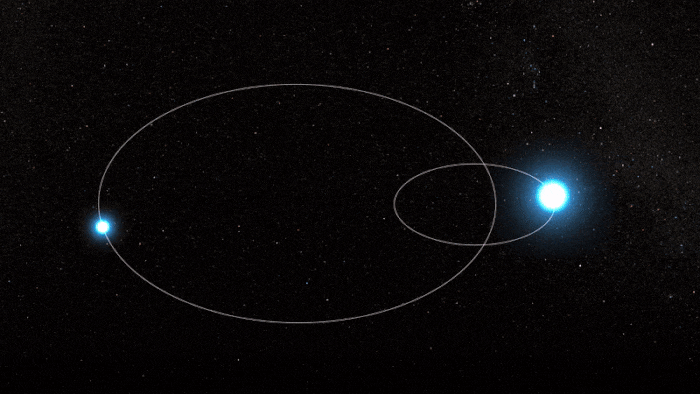
Ringed star is pushing matter into space
The James Webb Space Telescope captured this image of a star system dubbed Wolf-Rayet 140. The telescope’s infrared vision saw unusual concentric rings that appear to emanate off the star. Surprisingly, the rings are eminiscent of cartoon drawings of sound coming out of a blaring speaker. A team of scientists announced on October 12, 2022, that their study shows, for the first time, that the intense light from stars pushes matter.
The scientists observed violent interactions between two massive stars in Wolf-Rayet 140. Eventually, these interactions created a giant plume of dust that they tracked for more than 16 years using infrared images. The scientists published their results in the peer-reviewed journal Nature on October 12, 2022.
A complementary study, also published in Nature Astronomy on October 12, 2022, and based off the recent Webb telescope image, saw not just a single plume but at least 17 concentric rings.
What is Wolf-Rayet 140?
Wolf-Rayet 140 (WR 140) is a stellar system consisting of one huge Wolf-Rayet and an even larger blue supergiant star. A Wolf-Rayet star is a very massive, luminous and old star. Also, the two stars of Wolf-Rayet 140 are gravitationally bound binary stars. They orbit each other in a span of eight Earth years. The Keck telescope in Hawaii has been keeping an eye on this star system in Cygnus for two decades.
As these stars circle each other, they produce a plume of dust every eight years that stretches thousands of astronomical units (Earth-sun distances) long. Astronomers study these dust plumes to learn how starlight affects matter.

Starlight pushing dust
Light may not seem like it can exert a force on matter, but it can and it does. Light carries momentum and its push on objects is called radiation pressure. Astronomers have seen the result of this radiation pressure when they see matter moving at high speed through the universe. But seeing the acceleration from light directly is rare, and it’s the first time scientists have done so in a stellar environment. Lead author Yinuo Han of Cambridge’s Institute of Astronomy said:
It’s hard to see starlight causing acceleration because the force fades with distance, and other forces quickly take over. To witness acceleration at the level that it becomes measurable, the material needs to be reasonably close to the star or the source of the radiation pressure needs to be extra strong. WR 140 is a binary star whose ferocious radiation field supercharges these effects, placing them within reach of our high-precision data.
Powerful Wolf-Rayet stars have stellar winds that are stronger than your average star. In these winds, carbon condenses out as soot and remains white-hot so that it glows bright enough for infrared telescopes to spot. Using interferometry, the researchers got a sharper look at these rings.
How the dust forms
The dust from Wolf-Rayet 140 doesn’t stream out with the stellar wind in a nebulous ball. Instead it forms where the stellar winds from the two stars collide. The dust is on the surface of a cone-shaped shock front between the stars. As the stars orbit, the shock front rotates. This causes the dust to twist into a spiral, like water flying out of a garden sprinkler.
Because the orbits of the stars are elliptical, the dust flow turns on and off as the stars approach and recede from their closest approach. The scientists were able to model the dust locations in three dimensions. Co-author Peter Tuthill of the University of Sydney said:
Like clockwork, this star puffs out sculpted smoke rings every eight years, with all this wonderful physics written then inflated in the wind like a banner for us to read. Eight years later as the binary returns in its orbit, another appears the same as the one before, streaming out into space inside the bubble of the previous one, like a set of giant nested Russian dolls.
Capturing the push from the ringed star
The combination of the precise timing and large expanse of this phenomenon offered astronomers a unique chance to examine the acceleration zone. Han said:
In the absence of external forces, each dust spiral should expand at a constant speed. We were puzzled at first because we could not get our model to fit the observations, until we finally realized that we were seeing something new. The data did not fit because the expansion speed wasn’t constant, but rather that it was accelerating. We’d caught that for the first time on camera.
Tuthill said:
In one sense, we always knew this must be the reason for the outflow, but I never dreamed we’d be able to see the physics at work like this. When I look at the data now, I see WR 140’s plume unfurling like a giant sail made of dust. When it catches the photon wind streaming from the star, like a yacht catching a gust, it makes a sudden leap forward.
Observations from Webb
Ryan Lau of NSF’s NOIRLab led the study using the data from the Webb telescope. Lau said:
The Webb telescope offers new extremes of stability and sensitivity. We’ll now be able to make observations like this much more easily than from the ground, opening a new window into the world of Wolf-Rayet physics.
Let’s bring it closer to home: Webb’s MIRI instrument shows the best evidence yet that Wolf-Rayet stars can produce and preserve carbon-rich dust molecules, which could then be used to create new stars and planets. Our own Sun may have formed with help from a Wolf-Rayet star!
— NASA Webb Telescope (@NASAWebb) October 12, 2022
Bottom line: Wolf-Rayet 140 is a unique binary ringed star system that shows its intense light pushes dust into rings as the pair of stars orbit each other.
Source: Radiation-driven acceleration in the expanding WR 140 dust shell
Source: Nested dust shells around the Wolf–Rayet binary WR 140 observed with JWST











